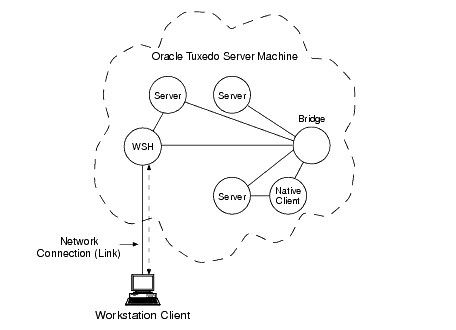







|
The following sections provide a brief overview of the Oracle Tuxedo ATMI Workstation component:
The Workstation component of the Oracle Tuxedo system allows application clients to reside on a machine that does not have a full server-side installation, that is, a machine that does not support any administration or application servers. As shown in the following figure, all communication between a Workstation client—an application client running on a Workstation component—and the server application takes place over the network.

| Note: | A Workstation client communicates with a server application through a workstation handler (WSH) process. |
A Workstation client, whether run on a Windows or UNIX system, has access to most of the client ATMI, although a Workstation client does not have all the access privileges available to a native client (that is, a client running on the same machine on which the server program is running). However, both types of clients can do the following:
tmadmin() command (for details, see tmadmin(1) in Oracle Tuxedo Command Reference)
Workstation clients do not have access to all the functionality available to native clients. For example, unlike a native client, a Workstation client cannot join an application as tpsysadm, which means that the client cannot subsequently subscribe to an event that issues a service call.
To integrate a Workstation client into an Oracle Tuxedo application, you must define any required and desired parameters for that client in the application configuration file. For details, see “Setting Up Workstation Clients” in Setting Up an Oracle Tuxedo Application.


|